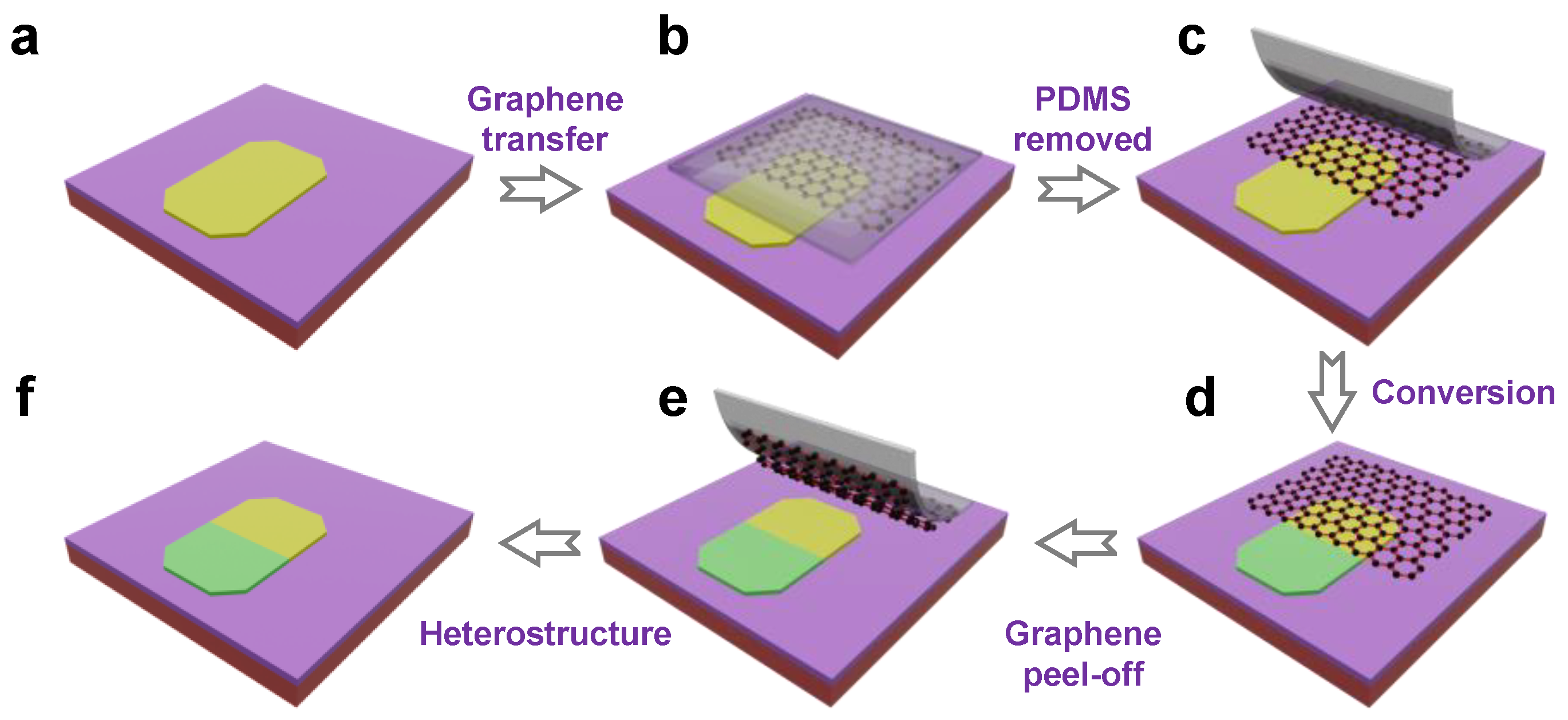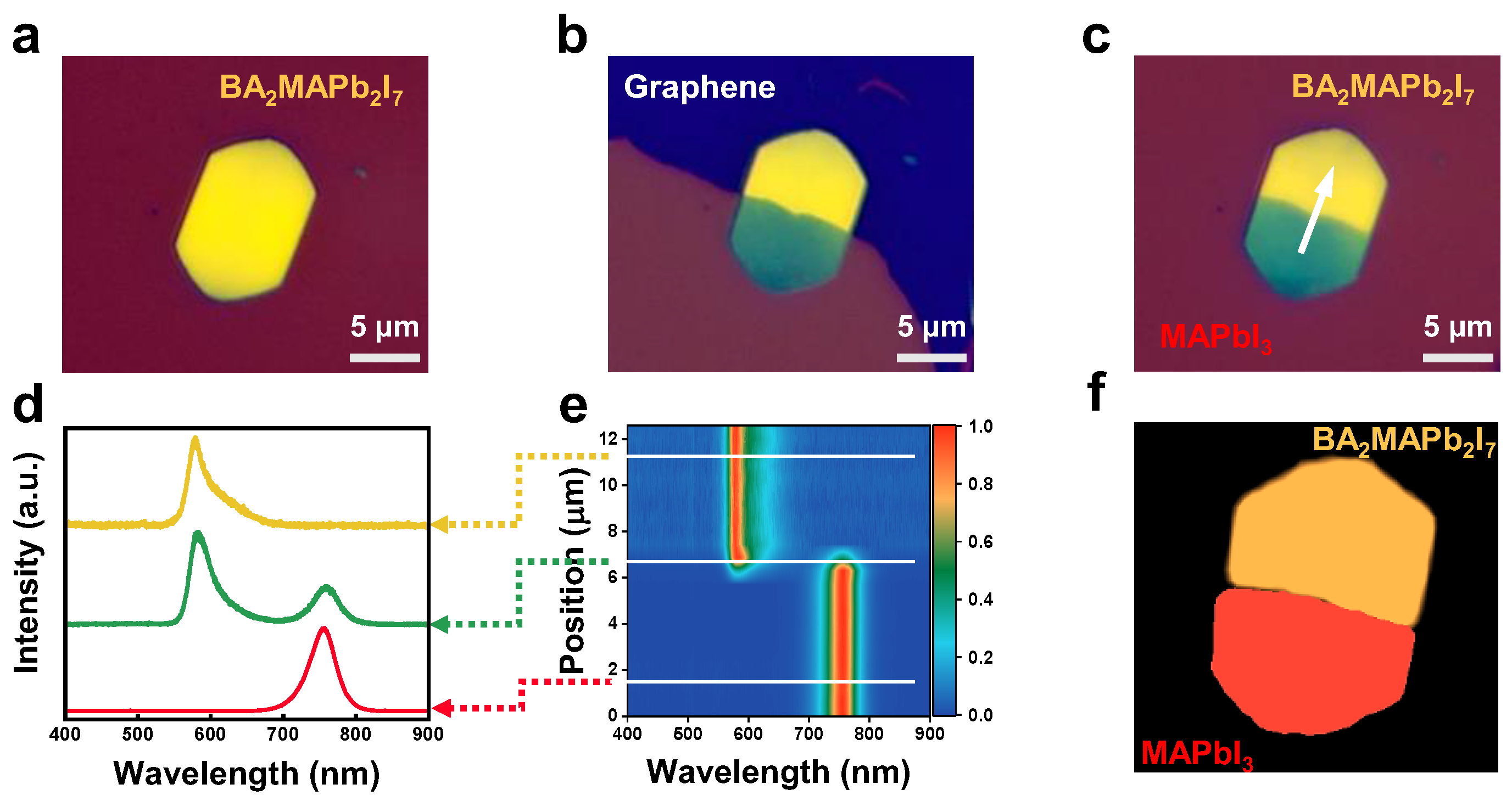Van Der Waals Mask-Assisted Strategy for Deterministic Fabrication of Two-Dimensional Organic−Inorganic Hybrid Perovskites Lateral Heterostructures
Abstract
1. Introduction
2. Results and Discussion
3. Experimental Section
4. Conclusions
Author Contributions
Funding
Institutional Review Board Statement
Informed Consent Statement
Data Availability Statement
Conflicts of Interest
References
- Deng, C.; Zhou, G.; Chen, D.; Zhao, J.; Wang, Y.; Liu, Q. Broadband Photoluminescence in 2D Organic–Inorganic Hybrid Perovskites: (C7H18N2)PbBr4 and (C9H22N2)PbBr4. J. Phys. Chem. Lett. 2020, 11, 2934–2940. [Google Scholar] [CrossRef]
- Zhang, L.; Wu, L.; Wang, K.; Zou, B. Pressure-Induced Broadband Emission of 2D Organic–Inorganic Hybrid Perovskite (C6 H5 C2 H4 NH3)2 PbBr4. Adv. Sci. 2019, 6, 1801628. [Google Scholar] [CrossRef] [PubMed]
- Ma, S.; Cai, M.; Cheng, T.; Ding, X.; Shi, X.; Alsaedi, A.; Hayat, T.; Ding, Y.; Tan, Z.; Dai, S. Two-dimensional organic-inorganic hybrid perovskite: From material properties to device applications. Sci. China Mater. 2018, 61, 1257–1277. [Google Scholar] [CrossRef]
- Han, X.; Zheng, Y.; Chai, S.; Chen, S.; Xu, J. 2D organic-inorganic hybrid perovskite materials for nonlinear optics. Nanophotonics 2020, 9, 1787–1810. [Google Scholar] [CrossRef]
- Guo, P.; Stoumpos, C.C.; Mao, L.; Sadasivam, S.; Ketterson, J.B.; Darancet, P.; Kanatzidis, M.G.; Schaller, R.D. Cross-plane coherent acoustic phonons in two-dimensional organic-inorganic hybrid perovskites. Nat. Commun. 2018, 9, 2019. [Google Scholar] [CrossRef]
- Wang, S.; Feng, S.; Li, R.; Jin, J.; Wu, J.; Zheng, W.; Xia, Z.; Chen, X.; Ling, Q.; Lin, Z. Multiexciton Generation from a 2D Organic–Inorganic Hybrid Perovskite with Nearly 200% Quantum Yield of Red Phosphorescence. Adv. Mater. 2023, 35, 2211992. [Google Scholar] [CrossRef]
- Kim, T.; Park, S.; Iyer, V.; Shaheen, B.; Choudhry, U.; Jiang, Q.; Eichman, G.; Gnabasik, R.; Kelley, K.; Lawrie, B.; et al. Mapping the pathways of photo-induced ion migration in organic-inorganic hybrid halide perovskites. Nat. Commun. 2023, 14, 1846. [Google Scholar] [CrossRef]
- Adhyaksa, G.W.P.; Veldhuizen, L.W.; Kuang, Y.; Brittman, S.; Schropp, R.E.I.; Garnett, E.C. Carrier Diffusion Lengths in Hybrid Perovskites: Processing, Composition, Aging, and Surface Passivation Effects. Chem. Mater. 2016, 28, 5259–5263. [Google Scholar] [CrossRef]
- Dakhil, T.; Hamidinezhad, H.; Baron, A.S. Fabrication and characterization of a hybrid organic-inorganic perovskite materials and applications in solar cell. Opt. Mater. 2025, 160, 116708. [Google Scholar] [CrossRef]
- Hasnain, S.M.; Iqbal, A.; Qasim, I.; Irshad, K.; Mir, M.A.; Malik, M.I.; Sundar, L.S. Performance evaluation of organometal halide MASnI3 and inorganic BaZrS3 hybrids in perovskites solar cells: Theoretical approach. Hybrid Adv. 2025, 9, 100408. [Google Scholar] [CrossRef]
- Liu, P.; Zhang, X.; Zhang, B.; Wang, Y.; Hu, W.; Qiu, F. Molecular engineering enables high-performance hybrid perovskite photodetector. Chip 2025, 4, 100125. [Google Scholar] [CrossRef]
- Kwon, H.; Lim, J.W.; Kim, D.H. Plasmonic perovskite photodetector with high photocurrent and low dark current mediated by Au NR/PEIE hybrid layer. J. Mater. Sci. Technol. 2025, 218, 45–53. [Google Scholar] [CrossRef]
- Hu, M.; Lyu, J.; Murrietta, N.; Fernández, S.; Michaels, W.; Zhou, Q.; Narayanan, P.; Congreve, D.N. 2D mixed halide perovskites for ultraviolet light-emitting diodes. Device 2024, 2, 100511. [Google Scholar] [CrossRef]
- Wang, Y.-Y.; Yan, J.-S.; Qu, H.; Zhu, L.; Zhang, Y.-N.; Feng, Y.; Wang, H.-J.; Zhang, J.; Li, Y.-Y. 2D organic-inorganic lead perovskite: Advancing X-ray detection capability. J. Alloys Compd. 2024, 998, 175013. [Google Scholar] [CrossRef]
- Liu, P.; He, X.; Ren, J.; Liao, Q.; Yao, J.; Fu, H. Organic–Inorganic Hybrid Perovskite Nanowire Laser Arrays. ACS Nano 2017, 11, 5766–5773. [Google Scholar] [CrossRef] [PubMed]
- Xu, Y.; Xu, H.; Zhu, P.; Xu, J.; Huang, Y.; Sun, Z.; Li, F.; Zhu, S.; Zhou, L. Broadband photodetection of intense lasers via exciton-enhanced high-order multiphoton-absorption optoelectronics in 2D hybrid perovskite. Sci. Adv. 2025, 11, eadt9952. [Google Scholar] [CrossRef] [PubMed]
- Hu, J.; Yan, L.; You, W. Two-Dimensional Organic–Inorganic Hybrid Perovskites: A New Platform for Optoelectronic Applications. Adv. Mater. 2018, 30, 1802041. [Google Scholar] [CrossRef]
- Li, C.; Loh, K.P.; Leng, K. Organic-inorganic hybrid perovskites and their heterostructures. Matter 2022, 5, 4153–4169. [Google Scholar] [CrossRef]
- Liu, Z.; Cheng, P.; Kang, R.; Zhou, J.; Wang, X.; Zhao, X.; Zhao, J.; Liu, D.; Zuo, Z. Piezo-Acoustic Resistive Switching Behaviors in High-Performance Organic–Inorganic Hybrid Perovskite Memristors. Adv. Sci. 2024, 11, 2308383. [Google Scholar] [CrossRef]
- Huang, Q.; Yang, S.; Feng, S.; Zhen, H.; Lin, Z.; Ling, Q. Multicolor Output from 2D Hybrid Perovskites with Wide Band Gap: Highly Efficient White Emission, Dual-Color Afterglow, and Switch between Fluorescence and Phosphorescence. J. Phys. Chem. Lett. 2021, 12, 1040–1045. [Google Scholar] [CrossRef]
- Ou, Z.; Wang, C.; Tao, Z.-G.; Li, Y.; Li, Z.; Zeng, Y.; Li, Y.; Shi, E.; Chu, W.; Wang, T.; et al. Organic Ligand Engineering for Tailoring Electron–Phonon Coupling in 2D Hybrid Perovskites. Nano Lett. 2024, 24, 5975–5983. [Google Scholar] [CrossRef] [PubMed]
- Chen, B.; Yu, R.; Xing, G.; Wang, Y.; Wang, W.; Chen, Y.; Xu, X.; Zhao, Q. Dielectric Engineering of 2D Organic–Inorganic Hybrid Perovskites. ACS Energy Lett. 2024, 9, 226–242. [Google Scholar] [CrossRef]
- Ma, L.; Wang, Y.; Liu, Y. van der Waals Contact for Two-Dimensional Transition Metal Dichalcogenides. Chem. Rev. 2024, 124, 2583–2616. [Google Scholar] [CrossRef] [PubMed]
- Gupta, N.; Sachin, S.; Kumari, P.; Rani, S.; Ray, S.J. Twistronics in two-dimensional transition metal dichalcogenide (TMD)-based van der Waals interface. RSC Adv. 2024, 14, 2878–2888. [Google Scholar] [CrossRef]
- Kim, B.S.Y.; Ngo, T.D.; Hassan, Y.; Chae, S.H.; Yoon, S.; Choi, M.S. Advances and Applications of Oxidized van der Waals Transition Metal Dichalcogenides. Adv. Sci. 2024, 11, 2407175. [Google Scholar] [CrossRef]
- Lv, Q.; Wang, X.-D.; Yu, Y.; Xu, C.-F.; Yu, Y.-J.; Xia, X.-Y.; Zheng, M.; Liao, L.-S. Lateral epitaxial growth of two-dimensional organic heterostructures. Nat. Chem. 2024, 16, 201–209. [Google Scholar] [CrossRef]
- Sahoo, P.K.; Memaran, S.; Xin, Y.; Balicas, L.; Gutiérrez, H.R. One-pot growth of two-dimensional lateral heterostructures via sequential edge-epitaxy. Nature 2018, 553, 63–67. [Google Scholar] [CrossRef]
- Wang, T.; Li, M.; Yao, L.; Yang, W.; Li, Y. Controlled Growth Lateral/Vertical Heterostructure Interface for Lithium Storage. Adv. Mater. 2024, 36, 2402961. [Google Scholar] [CrossRef]
- Mahjouri-Samani, M.; Lin, M.-W.; Wang, K.; Lupini, A.R.; Lee, J.; Basile, L.; Boulesbaa, A.; Rouleau, C.M.; Puretzky, A.A.; Ivanov, I.N.; et al. Patterned arrays of lateral heterojunctions within monolayer two-dimensional semiconductors. Nat. Commun. 2015, 6, 7749. [Google Scholar] [CrossRef]
- Spanopoulos, I.; Hadar, I.; Ke, W.; Tu, Q.; Chen, M.; Tsai, H.; He, Y.; Shekhawat, G.; Dravid, V.P.; Wasielewski, M.R.; et al. Uniaxial Expansion of the 2D Ruddlesden–Popper Perovskite Family for Improved Environmental Stability. J. Am. Chem. Soc. 2019, 141, 5518–5534. [Google Scholar] [CrossRef]
- Kumar, S.; Sharma, S.S.; Giri, J.; Makki, E.; Sathish, T.; Panchal, H. Perovskite materials with improved stability and environmental friendliness for photovoltaics. Front. Mech. Eng. 2024, 10, 1357087. [Google Scholar] [CrossRef]
- Ghimire, S.; Klinke, C. Two-dimensional halide perovskites: Synthesis, optoelectronic properties, stability, and applications. Nanoscale 2021, 13, 12394–12422. [Google Scholar] [CrossRef] [PubMed]
- Gao, X.; Zhang, X.; Yin, W.; Wang, H.; Hu, Y.; Zhang, Q.; Shi, Z.; Colvin, V.L.; Yu, W.W.; Zhang, Y. Ruddlesden–Popper Perovskites: Synthesis and Optical Properties for Optoelectronic Applications. Adv. Sci. 2019, 6, 1900941. [Google Scholar] [CrossRef] [PubMed]
- Zheng, B.; Zribi, J.; Zhu, C.; Avila, J.; Chaste, J.; Sun, X.; Liu, H.; Liu, Y.; Jiang, Y.; Zhu, X.; et al. Two-Dimensional Lateral Multiheterostructures Possessing Tunable Band Alignments. Chem. Mater. 2023, 35, 6745–6753. [Google Scholar] [CrossRef]
- Shehzad, N.; Saeed, S.; Shahid, I.; Khan, I.; Saeed, I.; Zapien, J.A.; Zhang, L. Two-dimensional van der Waals heterostructures (vdWHs) with band alignment transformation in multi-functional devices. RSC Adv. 2022, 12, 31456–31465. [Google Scholar] [CrossRef] [PubMed]
- Zhang, L.; Zhang, X.; Lu, G. Band Alignment in Two-Dimensional Halide Perovskite Heterostructures: Type I or Type II? J. Phys. Chem. Lett. 2020, 11, 2910–2916. [Google Scholar] [CrossRef]
- Lo, S.S.; Mirkovic, T.; Chuang, C.; Burda, C.; Scholes, G.D. Emergent Properties Resulting from Type-II Band Alignment in Semiconductor Nanoheterostructures. Adv. Mater. 2011, 23, 180–197. [Google Scholar] [CrossRef]






Disclaimer/Publisher’s Note: The statements, opinions and data contained in all publications are solely those of the individual author(s) and contributor(s) and not of MDPI and/or the editor(s). MDPI and/or the editor(s) disclaim responsibility for any injury to people or property resulting from any ideas, methods, instructions or products referred to in the content. |
© 2025 by the authors. Licensee MDPI, Basel, Switzerland. This article is an open access article distributed under the terms and conditions of the Creative Commons Attribution (CC BY) license (https://creativecommons.org/licenses/by/4.0/).
Share and Cite
Han, B.; Lin, M.; Tang, Y.; Liu, X.; Lian, B.; Qiu, Q.; Ding, S.; Xu, B. Van Der Waals Mask-Assisted Strategy for Deterministic Fabrication of Two-Dimensional Organic−Inorganic Hybrid Perovskites Lateral Heterostructures. Inorganics 2025, 13, 266. https://doi.org/10.3390/inorganics13080266
Han B, Lin M, Tang Y, Liu X, Lian B, Qiu Q, Ding S, Xu B. Van Der Waals Mask-Assisted Strategy for Deterministic Fabrication of Two-Dimensional Organic−Inorganic Hybrid Perovskites Lateral Heterostructures. Inorganics. 2025; 13(8):266. https://doi.org/10.3390/inorganics13080266
Chicago/Turabian StyleHan, Bin, Mengke Lin, Yanren Tang, Xingyu Liu, Bingtao Lian, Qi Qiu, Shukai Ding, and Bingshe Xu. 2025. "Van Der Waals Mask-Assisted Strategy for Deterministic Fabrication of Two-Dimensional Organic−Inorganic Hybrid Perovskites Lateral Heterostructures" Inorganics 13, no. 8: 266. https://doi.org/10.3390/inorganics13080266
APA StyleHan, B., Lin, M., Tang, Y., Liu, X., Lian, B., Qiu, Q., Ding, S., & Xu, B. (2025). Van Der Waals Mask-Assisted Strategy for Deterministic Fabrication of Two-Dimensional Organic−Inorganic Hybrid Perovskites Lateral Heterostructures. Inorganics, 13(8), 266. https://doi.org/10.3390/inorganics13080266




